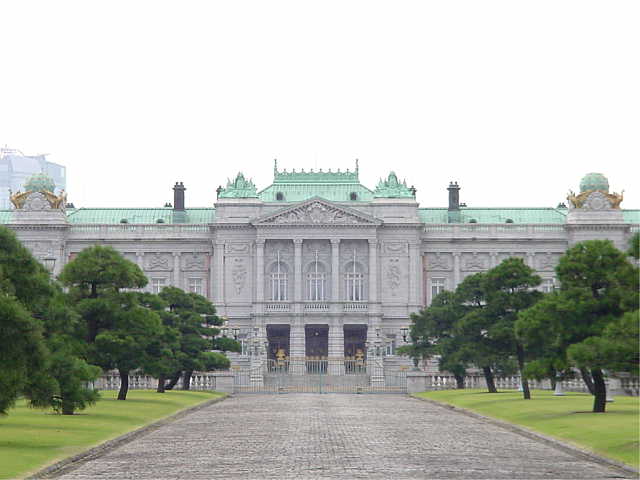| 名称 | 旧赤坂離宮(迎賓館 赤坂離宮) Geihin-kan Akasaka-Rikyu | 所在 | 港区元赤坂2丁目、迎賓館 |
| 設計者 | 片山東熊 他 | 建築年 | 明治42年築 |
 |
 |
| 拡大 画像クリック | 拡大 画像クリック |
|---|
|
迎賓館 赤坂離宮 迎賓館設立の沿革 迎賓館は、かつて紀州徳111家の江戸中屋敷があった広大な敷地の一部に、 明治42年(1909)に東宮御所(後に赤坂離宮となる。)として建設されたものです。 構造は鉄骨補強煉瓦造りで、地上2階、地下1階の耐震、耐火構造となっており、 明治時代の建築家片山東熊の総指揮の下に、当時の一流建築家や美術工芸家が総力を挙げて建設した、 日本における唯一のネオ・バロック様式の西洋風宮殿建築です。 この建物は、昭和天皇や今上天皇が一時期お住まいになった以外、東宮御所としてあまり使用されることなく、 戦後、建物、敷地共に皇室から行政へ移管され、国立国会図書館、内閣法制局、 東京オリンピック組織委員会などの公的機関に使用されていました。 この間、わが国が国際社会へ復帰し、国際関係が緊密化し、外国の賓客を迎えることが多くなったため、 国の迎賓施設をつくる方針がたてられ、これに伴い建設地や施設内容等の検討を行った結果、 昭和42年(1967)に「旧赤坂離宮」を改修してこれに充てることとなりました。 改修工事は昭和43年から5年有余の歳月と総額108億円の経費をかけて行われ、 賓客に対し和風の接遇を行うための別館の新設と合わせて、昭和49年(1974)に現在の迎賓館が完成しました。 開館以来、世界各国の国王、大統領、首相などの国賓、公賓がこの迎賓館に宿泊し、歓迎行事を始めとし、 政財学界要人との会談、レセプションでの懇談など、華々しい外交活動の舞台となっています。 また、先進国首脳会議(1979.1986.1993)、日本・東南アジア諸国連合特別首脳会議(2003)などの重要な国際会議の会場としても使用されています。 平成18年から3年間、大規模な改修工事を行い、平成21年(2009)4月から迎賓施設としての運用を再開しました。 同年12月、創建当時の建造物である旧東宮御所(迎賓館赤坂離宮)本館、正門、主庭噴水池等が国宝に指定されました。
The Histry of the State Guest House The State Guest House was originally built as the Crown Prince's Palace (later oalled the Akasaka Palace) in 1909 on a part of the vast site that was once the Edo (present-day Tokyo) estate of the Kishu-Tokugawa clan, one of the major branches of the ruling Tokugawa family. The building, made of bricks reinforced with steel frames, consists of two floors above ground and one below. It is an earthquake and fire resistant struoture. It was built by the concerted eftorts of leading architects and artisans under the overall direction of Dr. Tokuma Katayama, a famous Meiji-era architect. It is the sole neo-baroque style European palace building in Japan. However, the building was hardly used as a residenoe for the Crown Prince, except that Emperor Showa and the present Emperor resided for a short period. After World War ll, the management of the building and its land was transferred from the Imperial Household to the Government. It was subsequently used for public institutions and bodies such as the National Diet Library, the Cabinet Legislation Bureau and as an otfice of the Tokyo Olympics Organization Committee. During the postwar period, Japan reintegrated itself into the international community and developed closer ties with other countries. Since it was starting to welcome an increasing number of state and ofticial guests from abroad, a policy was developed to build a facility to accommodate them. In line with this policy, the process of choosing the location and studying details of the faoilities was initiated. As a result, it was deoided in 1967 to restore and remodel former Akasaka Palace to serve as the State Guest House. The restoration and remodeling works were completed in 1974, taking more than five years sinoe the start of 1968 and costing a total of 10.8 billion yen. At the same time, a Japanese-style annex building was newly built for receiving guests in a traditional Japanese atmosphere. Since its opening, the State Guest House has provided accommodations for state and official guests including monarchs, presidents and prime ministers from countries throughout the world. It has become an illustrious stage for diplomatic activities, such as welcoming ceremonies, meetings and reoeptions with leading figures in the political, business and academic circles. It has also served as a venue for important international conferences including the Tokyo G7 Summit meetings (1979, 1986, 1993) and the Japan-ASEAN Commemorative Summit of 2003. After the large-scale repair works, which started in 2006 and continued for about three years, the operations of the State Guest House restarted in April 2009. In December of 2009, the main building of the former Crown Prinoe's Palace (currently State Guest House, Akasaka Palace), together with the front gate and the fountain in the main garden, was designated as a national treasure.
|
| 旅のかけら| 飛べ 天空仙人| さくらのかんづめ| レトロ建築| 日本の名城 |
Copyright © 2006 I.HATADA All rights reserved.